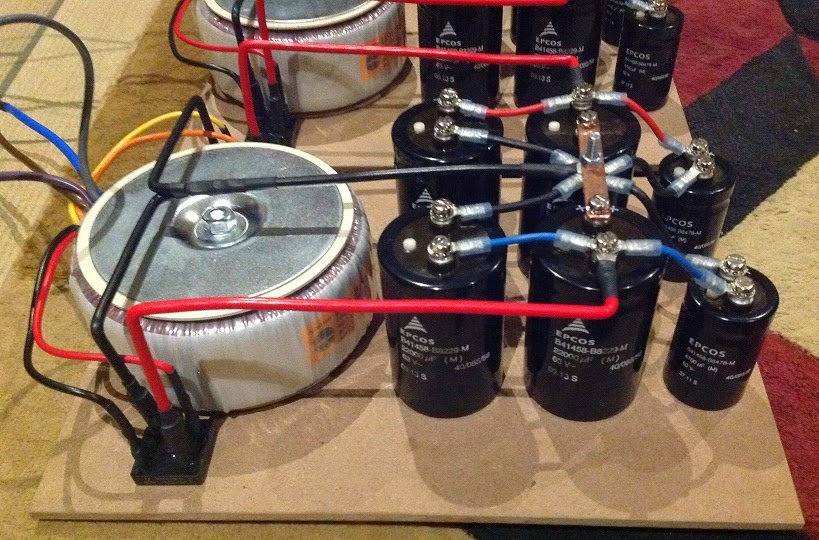The caption is a simple line which may be shrugged off by many as important, but only so much.
Personally I have experienced the difference an upgraded / uprated PSU can make twice now with my own designs. When you think about what an amplifier is really doing it makes a lot more sense: The amplifier circuitry modulates the DC power supply rails into an audio waveform based on an input waveform shape. If we break that down, then it means (over simplistic) that you are listening to the power supply rails.
Anyway, I finally took the time to build my large power supplies. Now running a 500VA transformer per amplifier + 48'700uF of big can type caps per rail, per amplifier. Did point-to-point wiring using 4mm copper for the main supply lines and 2.5mm coppper for secondary lines. I made up a beefy start ground point between 2 of the bigger caps, and applied the same wiring to the + and - rails as well. Here are some pics:


I powered these up for the first time last night. I was literally sitting with the power supply on a table, wearing my safety goggles, and had the fire extinguisher ready at hand just incase anything went horribly wrong. Fortunately both started up perfectly so my precautions were not needed :thumbs:
After checking both supplies, I connected them up to my amplifiers. This replaced a smaller power supply (using the exact same 500VA transformer) but on a PCB using EPCOS through hole type capacitors. Granted, I only used 15'000 uF worth of caps per rail per amp on the old supplies and this new supply uses more than 3 times that, but I was not prepared for the difference in what I heard listening to some music:
The sound is completely different! It sounds more relaxed somehow. At first I thought I was loosing some detail along the way but the amplifiers kept surprising me with the information it was able to bring to the speakers; but in a way that doesn't feel clinical or harsh or bright or taxing in any way. I actually spent more time listening than I had planned. It sounds damn great! What's even more surprising is that it seems like the new PSU is allowing for more staging and depth to be created somehow. Don't ask me how or why - all I know is that I now understand the reason behind spending some money on good quality large can type capacitors! Will I do the same again? Hell yes!
Cheers,
Ian.
Personally I have experienced the difference an upgraded / uprated PSU can make twice now with my own designs. When you think about what an amplifier is really doing it makes a lot more sense: The amplifier circuitry modulates the DC power supply rails into an audio waveform based on an input waveform shape. If we break that down, then it means (over simplistic) that you are listening to the power supply rails.
Anyway, I finally took the time to build my large power supplies. Now running a 500VA transformer per amplifier + 48'700uF of big can type caps per rail, per amplifier. Did point-to-point wiring using 4mm copper for the main supply lines and 2.5mm coppper for secondary lines. I made up a beefy start ground point between 2 of the bigger caps, and applied the same wiring to the + and - rails as well. Here are some pics:


I powered these up for the first time last night. I was literally sitting with the power supply on a table, wearing my safety goggles, and had the fire extinguisher ready at hand just incase anything went horribly wrong. Fortunately both started up perfectly so my precautions were not needed :thumbs:
After checking both supplies, I connected them up to my amplifiers. This replaced a smaller power supply (using the exact same 500VA transformer) but on a PCB using EPCOS through hole type capacitors. Granted, I only used 15'000 uF worth of caps per rail per amp on the old supplies and this new supply uses more than 3 times that, but I was not prepared for the difference in what I heard listening to some music:
The sound is completely different! It sounds more relaxed somehow. At first I thought I was loosing some detail along the way but the amplifiers kept surprising me with the information it was able to bring to the speakers; but in a way that doesn't feel clinical or harsh or bright or taxing in any way. I actually spent more time listening than I had planned. It sounds damn great! What's even more surprising is that it seems like the new PSU is allowing for more staging and depth to be created somehow. Don't ask me how or why - all I know is that I now understand the reason behind spending some money on good quality large can type capacitors! Will I do the same again? Hell yes!
Cheers,
Ian.
